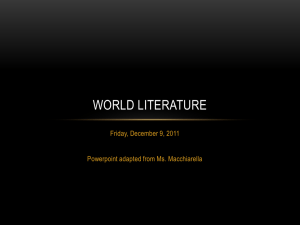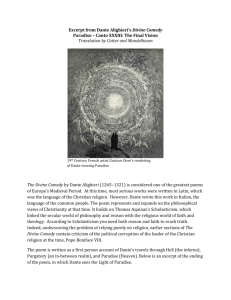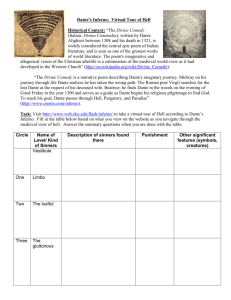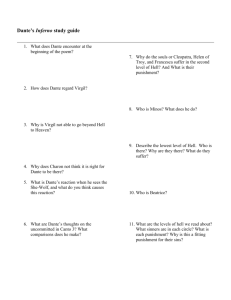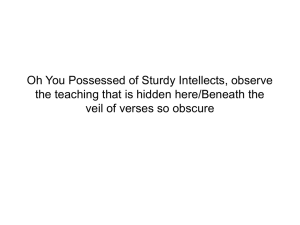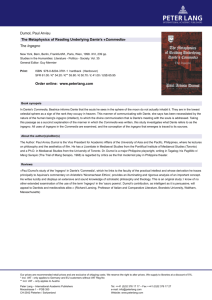the divine comedy - Loggia Gaio Cornelio Tacito n. 740
advertisement
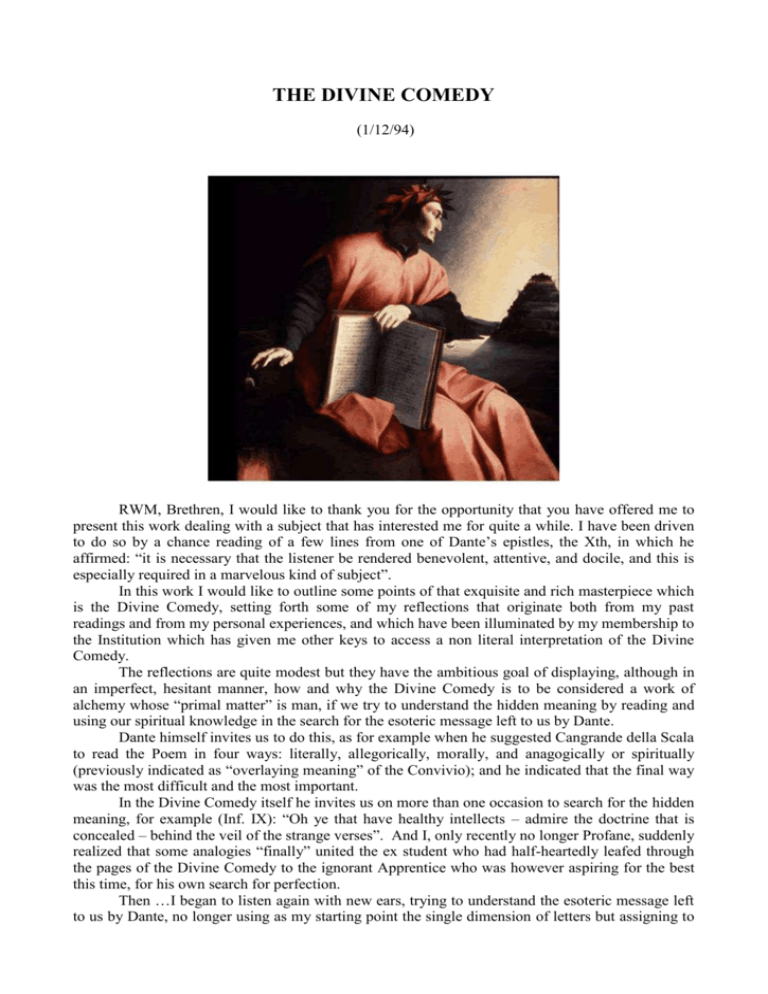
THE DIVINE COMEDY (1/12/94) RWM, Brethren, I would like to thank you for the opportunity that you have offered me to present this work dealing with a subject that has interested me for quite a while. I have been driven to do so by a chance reading of a few lines from one of Dante’s epistles, the Xth, in which he affirmed: “it is necessary that the listener be rendered benevolent, attentive, and docile, and this is especially required in a marvelous kind of subject”. In this work I would like to outline some points of that exquisite and rich masterpiece which is the Divine Comedy, setting forth some of my reflections that originate both from my past readings and from my personal experiences, and which have been illuminated by my membership to the Institution which has given me other keys to access a non literal interpretation of the Divine Comedy. The reflections are quite modest but they have the ambitious goal of displaying, although in an imperfect, hesitant manner, how and why the Divine Comedy is to be considered a work of alchemy whose “primal matter” is man, if we try to understand the hidden meaning by reading and using our spiritual knowledge in the search for the esoteric message left to us by Dante. Dante himself invites us to do this, as for example when he suggested Cangrande della Scala to read the Poem in four ways: literally, allegorically, morally, and anagogically or spiritually (previously indicated as “overlaying meaning” of the Convivio); and he indicated that the final way was the most difficult and the most important. In the Divine Comedy itself he invites us on more than one occasion to search for the hidden meaning, for example (Inf. IX): “Oh ye that have healthy intellects – admire the doctrine that is concealed – behind the veil of the strange verses”. And I, only recently no longer Profane, suddenly realized that some analogies “finally” united the ex student who had half-heartedly leafed through the pages of the Divine Comedy to the ignorant Apprentice who was however aspiring for the best this time, for his own search for perfection. Then …I began to listen again with new ears, trying to understand the esoteric message left to us by Dante, no longer using as my starting point the single dimension of letters but assigning to them the semantic multiplicity of meaning of symbols. The present contribution thus means to furnish some keys to better understand the hidden meaning in the Divine Comedy. Only after the start of the nineteenth century did scholars begin to propose anagogical interpretations. Among the first to do so were Foscolo, Rossetti, Pascoli, Valli; more recently Guénon, John and Cerchio among others believe that Dante was very connected with the Templars. In fact it is not improbable that the Order, an admirable fusion of monks, warriors, financiers that proposed an efficient example of theocratic regime, gave more than one stimulus to Dante’s doctrine of a supreme interdependency between Church and Empire. The sad destiny of the Temple permeates the Poem like something sinister; other historical events are narrated without concealment, while the tragedy of the Templars receives only rare scattered hints that however when put together form a disquieting picture. Those responsible for the destruction of the Temple are branded with harsher words than those used for other evil doers. Philip the Fair, who is vaguely defined as “he who rules France” in the Inferno (probably completed before 1312, year of the official abolition of the Order), stands out as a concentration of wickedness in Purgatory, which was conceived during the years of the disaster. Even before in ante purgatory we meet Philip III of France and Henry I of Navarre, father and father-in-law of Philip the Fair, who rather than regret their own sins lament those of the one who is defined “the evil of France”. Later on Dante meets with Hugh Capet, founder of the reigning French dynasty who defines himself in this manner: “I was the root of the evil tree – which overshadows all the Christian land – so that rarely good fruit is ever gathered there” (Purg. XX, 43-45). Even the choice of Saint Bernard as a final guide for the heavenly journey is not without importance: Saint Bernard is the inspirer of the Order of the Temple, which is perhaps hinted at with the choice of terminology “contemplating” and “contemplative” (Par. XXXI, 111- XXXII, 1). Dante’s presumed familiarity or membership with the Templars is interesting, because this could be the source from which he drew that esoteric knowledge that surfaces in his work. In fact we can consider the Divine Comedy as a text of medieval alchemy; in other words a text about the transformation of matter, of human matter, and of the fulfillment of the Work. Alchemy is the work of transmutation of metals by means of fire in order to obtain philosopher’s gold. The metal that we start off with is lead; heavy, dark, a symbol of the condition of matter, even of human matter, deprived of light and drawn towards the centre of earth’s gravity. Through a certain number of passages we reach, after the alchemist’s work, the attainment of philosopher’s gold; that is, matter which is transformed, perfect, full of light. The most illuminated alchemists were certainly conscious of undertaking a spiritual journey. They wanted to liberate the divine spark from the chains of matter that imprisoned it. To break the bonds of matter (primal matter, chaos, lead) it was necessary to proceed to the separation and solution (solve) of the conflicting elements (earth, water, air, fire). This phase was called “blackening”, or nigredo. Once the “first matter” was dissolved into its components, the marvelous substance, the mysterious substance, the lapis philosophorum had to be isolated by means of repeated distillations and successive coagulations into the albedo or “whitening” and from which was obtained the philosophical gold, liberating the divine particle imprisoned in matter. This is the phase of rubedo or “reddening”. Matter was thus liberated during the alchemical process from the heimarmene, in other words from the fate that was holding it prisoner with the influence of the seven planets; the process associated a metal to each of the seven planets. The seven part division can also be found in the symbolism of the seven days of the week, in the seven branches of the menorah. The metals are as follows: lead or Saturn, copper or Venus, tin or Jupiter, mercury or Mercury, iron or Mars, silver or the moon, and last gold or the sun. The corresponding days of the week follow a reversed order from Saturday to Sunday as the acrostic VITRIOL indicates, which means that we must change our direction which we believed was leading forward, while instead we must turn back and make a return to the centre, the centre of ourselves. Dante tells us of his journey that proceeds from the edge of the “circle to the centre” (Par. XIV). Also the labyrinth of Crete, which was made up of seven corridors and had a cross shaped centre, indicates this process of liberation from the layers of metal up to the manifestation. So Dante departs from a “dark wood” and heads toward the centre of the earth which was occupied by Lucifer “where all weights are drawn” (Inf. XXXIV) after having descended the seven circles of hell. Then he departs from a beach at the foot of Mount Purgatory and reaches the top of the mount climbing the seven mounds. He will then fly through the seven heavens, arriving past the stars at the mystic white rose. The symbolic structuring of the Divine Comedy is evident in its relation to the transmutation of metals. Hell represents the alchemic burner, the atanòr, whose retort can be identified with the “natural dungeon” through which Dante passes to arrive at the beach of purgatory. Also in regards to the cooking fire of matter, matter which is Dante himself, we find close parallels with the alchemic work. In hell fire is an energy that burns, that turns all into ashes, that boils. In purgatory it is a purifying fire, it is suffering and fatigue, but it is also a dazzling light in the aspect of the ministers of God, the angels, who come to meet the two pilgrims to have them progress from mound to mound. In paradise it is a beatific light that transcends both form and the senses, the light of love which is reflected from soul to soul like a beam of light reflecting from mirror to mirror. Without the movement of this fire-love the progress of the poet along his other worldly journey would be unthinkable. This fire-love, that “moves the sun and the other stars”, is also the fire-sun that comforts the pilgrim in the dark wood, it is what is lacking in hell, and without which it would be impossible to proceed through purgatory. It is also what multiplies at the beginning of paradise both outside as well as within Dante. It is the fire of conscience, it is divine fire, not human fire. This is what the alchemists meant when they spoke of fire. Hermetic matches between the heavenly and infernal circles Inferno Paradise The indolent (ante inferno) Spirits who couldn’t keep their vows (1st heaven: moon) Active spirits (2nd heaven: Murcury) Loving spirits (3rd heaven: Venus) Wise spirits (4th heaven: sun) Spirits militant for the faith (5th heaven: Mars) Just spirits (6th heaven: Jupiter) Contemplative spirits (7th heaven: Saturn) Limbo (1st circle) The lascivious (2nd circle) The greedy, stingy, prodigal (3-4 c.) Wrathful, sullen, violent (5-6-7 c.) The fraudulent (8th circle) Traitors (ninth circle) In the first canto of the Divine Comedy the two possible ways for the fulfillment of the alchemic process are indicated: the “dry” way and the “wet” way. The dry way, or the direct way requires a direct confrontation with the wild beasts. Dante does not feel himself able to follow this way to get out of the dark wood, or rather to transform primal matter. Such a “short cut” is impracticable, he doesn’t feel himself worthy (your soul is offended by faint-heartedness” Virgil tells him). The wet way, or the indirect and long way requires on the other hand humility and corresponds to the pilgrim’s journey through the three kingdoms. This is the journey that Virgil advises: “You had better keep to another journey – he answered then at the sight of my tears – if you wish to get out of this wild place” (Inf. I, 91-93). In the Divine Comedy the accomplishment of nigredo corresponds to the Inferno, that of albedo corresponds to Purgatory, that of rubedo corresponds to Paradise. By means of nigredo we must attain the dissolution of physical essence through initiatic death. The work of blackening is the most dangerous because it is necessary to dominate the primordial and chaotic energy of matter, of physical essence, of the id’s instinct tied to its own individuality. Primordial Energy, however chaotic it may be, is still the manifestation of the divine principle, for this reason it would be inopportune to morally condemn it. The initiate has the task of rectifying it (VITRIOL). The three savage beasts: the leopard, the lion, and the wolf symmetrically correspond to the three heavenly women who call Dante on his journey: Beatrice incarnates Wisdom, Lucia (anagram of acuil-aquila) incarnates Justice, Maria incarnates Power, being “there where all that you want you can”. The leopard is then supposed to represent the corruption of wisdom, the division of the single and sacred knowledge into the multiplicity of profane knowledge; for this reason its skin “with spotted fur was covered”. Initiation on the other hand is the means by which we surpass profane knowledge and attain Wisdom, following the way of Ars Regia. The Great alchemic Work must begin as close as possible to the Spring equinox, and so Dante hopes to get beyond the leopard because “ Despite the beast with gaudy fur, I still could hope for good, encouraged by the hour of the day and the sweet season”. The leopard rather that representing lasciviousness as is usually thought, represents instead the degenerate form of an energy: the love for knowledge, such energy rectified leads to Wisdom. The lion and Lucia are linked by more direct comparisons: how not to see in the “high head” and in the “rabid hunger” the violence, the blind and ferocious force which oppresses right? The symbolism of the wolf is also clear, power that longs to become action, taking shape in individual and material forms; it is the blind vital force that keeps us attached to our id, to our individualism, holding back the alchemical dissolution, the premise for the conquest of transcendence. The Work of Blackenin calls for a descent to the interior of the earth, to ones inner id (“know thyself”), to rectify energy in the sense of transcendence. To do this Dante comes before Lucifer (who is divine and three headed, a reverse image of the higher trinity) and it is here that he undergoes an interior transformation, a 180° change of direction. Mind (Virgil) is what implements the getting through; the passage is so instantaneous that Dante does not notice it. The overturning, which is an interior event, inaugurates a new way of seeing which we do not immediately realize. “I raised my eyes and thought I saw-Lucifer as I had left him-and I saw him with his legs held aloft” (Inf. XXXIV, 89-90). We thus move on from the human illusion of being the centre of the universe to the intuition of a reality that transcends this illusory centrality. The process of nigredo is finished from an alchemical point of view, the black stone has been found, leaden-saturnine materialism which opportunely treated will give origin to the philosopher’s stone. Now a sign must appear on the absolute black of the alchemical “compost”: the star (“and then we went out to see the stars again”). It is the dawn of Easter of the year 1300. It is time to condense the spirits (coagulate), the “albedo” begins, it is the catharsis, the rebirth. The kingdom of earth is succeeded by that of water and air (Purgatory), a prelude to the celestial fire. The dissolved matter must now be purified in water, to be reborn from putrefaction into the purity of its constituting elements, reintegrating the personality in a higher state. The alchemical “recipe” for this operation calls for fixing the “mercury” by uniting it with “Saturn”; in other words the vital spirit (Murcury) which had been liberated in the course of the work of blackening from the bonds that had kept it prisoner inside matter (Saturn) re emerges; but it must once again be united with matter-saturn in an overturned functional relationship (spiritualize the body giving body to the spirit-volatilize what is fixed by fixing what is volatile). The product of such a union (the so called “chemical wedding”) is emblematically represented by the androgyne, the male-female being which evokes primordial unity. The androgyne is unity which transcends dualism; for this reason it is also called Rebis (res-bis, two things in one). In the terrestial Paradise, once the tensions between heaven and earth have been overcome, what initiatic tradition calls “primordial man” is restored, the reflected image of God (God will reveal himself to Dante only in the celestial Paradise); thus we reach a state no longer of innocence but of purity. In the third canticle, Paradise, Dante attains the fulfillment of the work of reddening, which is self identification in the eternal; he becomes one with the divine principle, and he becomes a participant of its essence (Dante uses the terms “trasumanar” and “india”). He has experienced the living God from the most hidden recesses of hell up to the final union with Him. All that he has “seen” transcends his time and the personality of the individual, it regards all humanity. The scope of the message that Dante left us is enormous. The message of salvation for humanity is projected onto Christ at the beginning of the work, but, by the end of the journey the certainty that salvation is imminent in each of us comes to Dante in a momentary flash. In all of us, in fact, totality is present, expressed in the final vision following the sacred union between the Spirit and the Anthropos, who represents all humanity reintegrated in Mary the Great Mother. Quaternity is a symbol of totality; but what does the opposition of triad and quaternity mean, and what does the triad mean in the face of totality? For alchemists this problem is called Mary’s Axiom. Three, as a masculine number, four, as a feminine number; there is first of all the malefemale opposition between the triad and the quaternity. Mary is the Earth which generated us, gave us life, built our bodies: her blood, which falls from the clouds, springs from her womb murmuring in mountain brooks, it flows inside of us; the air that we breathe is her breath which is azure in the summits of heaven… We are in Her, She is in us; we are born from her, we live in her and we will return to her the day in which we will have to return our body to her… Dante’s final realization was that man was born of Mary, the feminine state of Love (“woman is gentle in heaven, who mourns”, Inf. II, 94). Mary welcomes man into the splendor of the final Rose, who in imitatio Christi accepts the death of his own egoism to be born again within himself to the divine, accomplishing that hieros-gamos between matter and spirit that leads to the fulfillment of the Unus Mundus. “Those who have renounced works in their id; those for whom I am the only object and who, with an exclusive Union contemplate me and serve me, I immediately remove them from this series of death alternatives, because their thoughts are with me. Therefore free your spirit, place your reason in me, and immediately after without a doubt you will live in me” (Baghavad-Gita). The new man, reintegrated by Dante in his process, comes from below, from the night, from the shadowy prisons of vice. He is extracted with a process of spiritual alchemy from the “primal matter” (the “jungle”). The “primal matter” is in of itself transcendent (as on high, so below), and we can only see its phenomenology. Grace, the Eternal, spiritual feminine comes from on high to the aid of this maternal earthly mystery. Alchemically accomplishing the coincidentia oppositorum the circle of universal effects is closed, harmonizing in the Cosmic Unity what is apparently discordant, demonstrating the essential oneness of physical and metaphysical reality; it is the return to the perfect primevil indifferentiated identity At the end of the heavenly voyage Dante clashes with the mystery of evil, which is part of an invisible divine plan (“creating every mind in his own bliss, variously bestows His grace and as He pleases -- and in this case let the fact suffice” Par. XXXII, 64-72). The presence of evil in the world, the meaning of the rise and fall of civilizations, depend on man, but also on unknown factors (fortune, predestination…). When man re enters with this consciousness into phenomenal life, he must avoid falling in one opposite situation or the other (good-evil), but every time remain in the middle of the ethical choice (build temples to virtue, dig deep and dark prisons to vice). The relevance of Dante’s message consists in man’s eternal search to awaken the “celestial man” that sleeps within, to accomplish his immortal nature. To do this we must abandon our habits, our automatic reactions that we use in everyday life, we must make a sacrifice, leaving life as we have led it up to this moment; we must “die”, descend into hell to be reborn. Dying and being born again are an interior experience that are difficult for the profane to understand, but clear for the initiated. “Verily, verily, I say unto thee, except a man be born again, he cannot see the kingdom of God. That which is born of the flesh is flesh; and that which is born of the Spirit is spirit. Marvel not that I said unto thee, Ye must be born again.” (John III, 4-7) After the “voluntary death” to profane life, we are reborn to life no longer to be as a “person”, but as conscience of being (Dante says: “I found myself again”) Let us leave behind us our preceding life full of contradictions: the chaos, the jungle; and let’s dare to enter with open eyes in a new life, penetrating and revealing the great mysterious first born of all mysteries: the polar Unity of life and death, of spirit and matter, the harmonious Union of Earth and Sky that leads to the discovery of the “true man”, of the “celestial man” which is potential in all of us: this is the task that especially we Masons have, who work for the good and the progress of humanity with our interior search for perfection.
